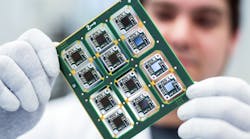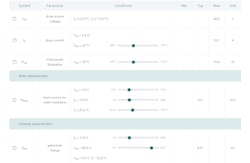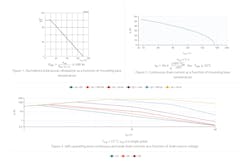Is the Future of the Datasheet Interactive?
Check out our coverage of PCIM 2023. This article is also part of the TechXchange: PCB Tools and Technology.
Almost every circuit board starts out as a concept drawing scrawled on a napkin or scribbled on a whiteboard in a company’s office. But it only starts to take shape once engineers start selecting components that are up to the job.
To assemble a list of appropriate parts, engineers must sort through vast component databases. The process involves digging into datasheets—and potentially thousands of pages of facts and figures—and interpreting the information within to figure out whether a potential device will work in the context of a specific PCB.
Component selection is frequently a long and tedious process. To take the pain out of the process, Nexperia rolled out a series of “interactive datasheets” that can more accurately communicate how a device will work under varying conditions.
By manipulating interactive sliders within the datasheets, users can manually adjust the voltage, current, temperature, and other conditions in a circuit and watch how the operating point of the device being evaluated responds in real-time.
Nexperia said more than 200 interactive datasheets are already available, covering the company’s new generations of automotive- and industrial-grade power MOSFETs, including this one.
Insufficient Insight
When trying to decide what components to choose for the final PCB, the datasheet is often the first place you go. Every component out there comes with a datasheet that you need to carefully review to understand how the part will perform in a specific design. There are thousands of relevant parts to choose from for a given project, and datasheets themselves can be more than 100 pages in some cases.
Datasheets contain a wealth of information about the device and how it operates, including minimum, maximum, and typical specifications for the device in different situations. But according to Nexperia, they rarely tell you everything you need to know.
Many device characteristics listed on the datasheet are very closely related. Even changing a single variable—for instance, the operating temperature of a power FET—can influence many other aspects, including the threshold voltage (VTH) and on-resistance (RDS(on)) of the FET. Having to limit the power dissipation of the device may also impact various voltages and currents that run through it.
It can become confusing trying to connect the dots between the distinct characteristics of the device. That could cause engineers to incorrectly assume they know how the device will work in the context of a design.
Today, engineers must manually calculate how the information in a datasheet will translate to a design deployed out in the field. But that may take a long time, warned Nexperia, as it’s necessary to transcribe all of the relevant data manually.
Alternatively, engineers can use CAD software powered by models from the manufacturer (assuming they’re available) to investigate how the device will behave in the real world. But even so, many of these models fail to capture how temperature and other conditions can impact a device.
In the end, there’s no wrong way to work through the component selection process. But calculating the operation of a device by hand or even simulating it in software can waste time in the design process.
Less Wasted Time
The new interactive datasheets from Nexperia save time by giving engineers more insight into components they’re evaluating for a design, improving productivity in the early stages of a project.
The datasheets effectively give users a graphical user interface (GUI) that can calculate the operating point of the device. These newer features are powered by the same technology as the electrothermal models that the company has offered for many of its power MOSFETs.
Nexperia said the interactive datasheets can be used by engineers to view how different parameters, including gate voltage, drain current, and power dissipation, and characteristics such as the on-state resistance of a device, interact. As engineers use the easy-to-use sliders to adjust the conditions of a device, the datasheets can display results dynamically in a series of tables and graphs.
The new tools aim to help engineers evaluate components with ease, giving them more time to spend on designing products and less time sorting through datasheets and documentation.
In addition to the interactive datasheets, traditional static datasheets will be available, too. They can run on any standard web browser without the requirement of additional software for device simulation.
The company plans to check in with customers around the world to determine how they’re using the interactive datasheets. It hopes to use what it learns to improve the utility of future offerings.
Long range, Nexperia intends to expand the interactive features to a broader range of components.
Check out more of our coverage of PCIM 2023, and read more articles in the TechXchange: PCB Tools and Technology.



